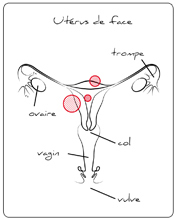Breast surgery
Adnexa surgery
Uterine surgery
Cervical surgery
Vulvar surgery
Other
Myomectomy

Definitions
A fibroid is a common benign tumor, especially for women around 40. The exact origin of the fibromas is unknown. However, it is acknowledged that the development of this benign tumour is only possible in the presence of oestradiol. This explains the absence of fibroma before puberty and their regression after the menopause. A myomectomy consists of the surgical ablation of one or more uterine fibromas while preserving the uterus. It thus preserves the menses and the possibility of later pregnancy.
Surgical techniques
Myomectomy can be performed under a general anaesthesia or a local one (epidural block or spinal anaesthesia).
Whatever the access way is, the operation is performed by an incision of the uterus, the ablation of the uterine fibroid(s) and the suture of the wall of the uterus. This operation can be realized by a full abdominal incision (also called laparotomy), either horizontally or vertically (depending of the antecedents or particular circumstances). In certain situations, the myomectomy can be performed by laparoscopy: the fibroids are removed through the small portholes of laparoscopy, after “morcellation”.
The hospitalization stay is then reduced by 6 to 3 days and the work leave from 1 month to approximately 15 days.
Risks & Complications
In spite of a meticulous procedure, it is not possible to guarantee neither the therapeutic success nor the absence of complications.
Post-operation
- Blood tumor or abscess in the abdominal wall: it generally requires local care, but a surgical evacuation may be an option.
- Significant blood loss: may rarely lead to a blood transfusion.
- Lesions of an organ close to the uterus: this can exceptionally happen: intestinal, urinary tracts or blood vessels wounds, requiring a specific surgical assumption.
En post-opératoire
- L'hématome ou l'abcès de la paroi: Il nécessite le plus souvent des soins locaux, mais une évacuation chirurgicale est rarement nécessaire.
- Lower extremity deep venous thrombosis and pulmonary embolism: in order to prevent this kind of complication, an early rising is recommended, as well as wearing support stockings and daily injections of anticoagulant.
- Bowel obstruction: It can require a medical care, even a surgical operation.
Last update: 10/2/2013
